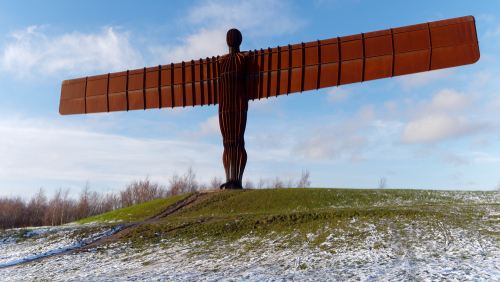
Gateshead is a large town and borough in the metropolitan county of Tyne and Wear, in north-east England. Located on the south bank of the River Tyne, opposite the city of Newcastle. The two settlements are linked by seven bridges. The town is well known for its architecture, which includes the Sage Gateshead, the Angel of the North and the Baltic Centre for Contemporary Art. Residents of Gateshead, like the rest of Tyneside, are referred to as Geordies’, and their dialect as ‘Geordie’.
Gateshead A Fleeting History
The first settlers in the area are thought to be the Romans. It is surmised, the settlement grew up around the old river crossing at Pipewellgate and Oakwellgate, where the Swing Bridge now stands. Some historians believe Gateshead may have been the Roman fort of Gabrosentum, although there is currently little archaeological evidence of Roman activity in the area.
The first recorded mention of “Gateshead’ is in the writings of the Venerable Bede in AD 623, who referred to ‘Utta’, the Abbot of Gateshead. Bede’s Latin translation gave the name as ‘at the goat’s head’, which was consistent with a later literal English translation as ‘goat’s head’, in the context of a headland where the goats roam.
In 1068, William the Conqueror defeated the forces of Edgar the Ætheling and King Malcolm of Scotland on Gateshead Fell (now Low Fell and Sheriff Hill) taking control of the area. In 1072, under Norman rule, the position of the Bishop of Durham was established. The town fell under the jurisdiction of the Bishop, however, the area at the time, was largely forest and wasteland, with only a small amount turned over to agriculture. The forest was the subject of Gateshead’s first charter, granted around 1164 by Hugh du Puiset, the Bishop of Durham.
Not In the Doomsday Book!
Gateshead was not included in the Domesday Book but instead was included in a survey of the Bishopric of Durham, which was recorded in the Boldon Book. In 1183, Gateshead is listed as having watermills, bake-houses and salmon fisheries. Coal mining is first recorded as taking place in the area as early as 1344. As trade on the Tyne prospered, there were ongoing attempts by the Newcastle Burgesses to take control of the town. In 1576, a small powerful group of Newcastle merchants managed to acquire the ‘Grand Lease’ of the manors of Gateshead and Whickham, which were deemed to be amongst the best coalfields in Europe.
Over the next century, the coal mines were exploited to the limit. Local coal production increased eleven-fold, while the population of Gateshead doubled to around 5,500. However, in 1680, the lease expired, and the abundant coal supplies came to a premature end. Problems with ventilation and flooding in the pits meant it proved impossible to mine coal from deeper seams. Gateshead subsequently slid into a state of despair, many people had rent arrears, the area was scarred with slag heaps, and poor-quality land meant low crop production.
The town’s fortunes were not revived again until the arrival of the industrial revolution in the mid-eighteenth century. Amongst other industries, glassworks and ironworks were established in the town, creating jobs. Of particular note, was the ironworks set up by former blacksmith, William Hawks in 1748. Once again, Gateshead’s prospects began to look rosier.
Nineteenth-Century Gateshead
In 1831, the locomotive works were established in the town by the Newcastle and Darlington Railway. In 1840, Robert Stirling Newall set up his wire rope manufacturing operation. The company became highly successful, making deep-sea cables for clients around the world. The 1830s saw further significant changes for the town. In 1835, Cuthbert Rippon became the town’s first elected Member of Parliament, and a Poor Law Union was set up in 1836.
The town was amongst the first to get electric lights thanks to Joseph Swan’s invention of the electric light bulb. His house at Underhill, Low Fell was the first in the world to be wired for domestic electric light.
Throughout the 19th century, Gateshead’s population had expanded rapidly; from 8,597 at 1801 Census, to 122,447 at 1901 Census. The town’s expansion spread southwards along the river, mostly in the form of terraced houses for the working-classes. The character of the town changed from rural to very much urban.
In 1889, Gateshead was made a county borough. In the same year, one of its largest employers, Hawks Crawshay Ironworks, was forced to close down. In 1909, locomotive construction, which had spent almost 80 years in the town, moved to Darlington. By this time, unemployment had become a severe problem in the town, as deputations were sent to the council on a regular to ask for work. The Great Depression of the 1920s and ’30s created even more unemployment. In the mid-1930s, the Team Valley Trading Estate was built to help with alleviating the unemployment situation.
In 1951, Gateshead’s borough boundaries were extended to provide building land and facilitate slum clearance.
Modern Gateshead
During the 1950s attempts to solve the chronic housing shortage saw the construction of tower blocks and ‘village’ concepts. In the 1960s and ’70s, much of the old town was cleared to provide relief roads, flyovers and bypasses that largely enabled better connectivity to Newcastle. This had the effect of leaving the town somewhat isolated, and even more in the shadow of its more famous neighbour; Newcastle.
From the 1980s Gateshead started the process of slow regeneration. The building of the Metro Centre in 1986 and the National Garden Festival in 1990, were the catalyst for further civic and social development. Regeneration of the quayside has seen the construction of some high profile projects such as the Millennium Bridge, the Baltic and the Sage, take place. And of course, the erection of Anthony Gormley’s world-renowned sculpture the ‘Angel of the North’ has only added to the town’s civic pride.
Gateshead continues to change, as thousands of new houses have replaced the old substandard terraces, derelict areas have been reclaimed, and new roads constructed with the future in mind. The town centre has also recently been refurbished, with the £150m Trinity Square development, opening in May 2013.
The town’s population was recorded at the 2011 Census was 120,046.
Getting To Gateshead
Road
It’s fairly easy to get to from all parts of the country if you are travelling by car – just follow the signs for Newcastle! The most direct and easiest way to get here from London and the south, and Edinburgh and the east of Scotland, is via the A1. The A19 brings you north to the city from Sunderland, Middlesbrough and most of Yorkshire. The A69 is the principal road link from Carlisle and the north-west. The A696/A68 passes the Airport, links Newcastle and Gateshead with central Northumberland and central Scottish Borders. Similarly, the A167, (formerly, the ‘Great North Road’) links Gateshead to the north with Newcastle, and with Chester-le-Street, Durham and Darlington to the south.
Rail
Gateshead does not have a train station so if you’re looking to travel by train to the town, then head for Newcastle. Gateshead is just one stop, a couple of minutes ride, after Newcastle Central Station on the Metro Line.
Newcastle Central Station and is a principal stop on the East Coast Main Line. Train operator London North Eastern Railway (LNER) provides a service to London’s King’s Cross. Trains run approximately every 30 minutes with a 3 hours journey time. Most of the LNER trains also connect between Newcastle and Scotland, with all trains calling at Edinburgh Waverley. Several of the Edinburgh trains go on to connect with Glasgow Central, Aberdeen and Inverness. The Cross Country trains serve Newcastle from destinations in Yorkshire, the Midlands and the South West. TransPennine Express operates services from Newcastle to Manchester Airport and Liverpool Lime Street. Northern Rail provides local and regional services.
The Metro
The Tyne & Wear Metro is a light rail system that serves much of the region. The Metro consists of two lines; the Green Line and the Yellow Line. The Green Line runs between Newcastle Airport and South Hylton, via Newcastle city centre, Gateshead and Sunderland. The Yellow Line runs between St James’s and South Shields, via North Shields, Tynemouth and Whitley Bay. It loops back through Newcastle city centre, and then runs due east to South Shields, via Gateshead and Jarrow.
Buses
Gateshead Interchange is a transport interchange in the centre of the town. It serves as a connection between the Metro, whose station is underground, and local bus services. The bus station is the busiest bus station in Tyne and Wear.
Express bus route X66 links the Interchange with the Metro Centre. There is a regular Q1 QuayLink bus service that goes from the Interchange, to other local attractions such as The Sage and Baltic Centre for Contemporary Art and onwards to Newcastle city centre.
The three main operators that provide bus services in and around the town and further beyond are Arriva North East; Go North East and Stagecoach North East. Arriva provides services to the north of Newcastle, Northumberland and North Tyneside. Go North East provides services to Newcastle, South Tyneside, Sunderland, and County Durham. Stagecoach mainly operates services between the Metro Centre and Newcastle.
Newcastle coach station, near Central railway station, provides long-distance bus services to and from the rest of the country, operated by National Express.
Airport
Newcastle International Airport is obviously the nearest airport. It’s located approximately 9 miles (15 km) from the town, on the outskirts of Newcastle, near Ponteland. It is connected via the Metro rail system. The journey time into Gateshead via the Metro is approximately 30 minutes. There are numerous short-haul and long-haul flights to multiple world destinations from the Airport.
Places to see!
Angel of the North

Image: Philip Bird LRPS CPAGB/Shutterstock.com
The iconic ‘Angel of the North’ statue has perhaps more than anything else become a symbol of North East pride and culture. It stands 20 metres high and 54 metres wide, on a hill at Birtley, overlooking the Gateshead landscape. The statue was created by world-renowned British sculptor Sir Antony Gormley and completed in 1998. Constructed in Hartlepool using weather-resistant steel, the statue is admired by over 150,000 visitors a year. It’s said that the statue represents the region’s transition from an industrial to the information age.
Millennium Bridge
The Millennium Bridge is one of the seven bridges that connect Gateshead and Newcastle. If you are in either location for the first time, then it’s worth putting a visit to the bridge on your itinerary. Famous for being the world’s first tilting bridge, it was commissioned by Gateshead Council, with the intention of making its major cultural developments, especially the BALTIC Centre, the Sage music centre, more accessible from Newcastle Quayside.
To get there just jump on the yellow Quaylink bus. The bus links Gateshead and Newcastle waterfronts, running every 15 minutes during the day, and every 30 minutes, in the evening. The bridge ‘tilts’ once per day, except Saturdays when the operation is carried out twice. You can check the scheduled times for tilting on Gateshead Council’s website, but it’s usually around noon or early evening.
Things to do!
Sage Gateshead
If you are in the Quayside area, it’s hard to miss Sage Gateshead, as the distinctive building dominates the skyline. It’s an exclusive music venue, designed by world-renowned architect Norman Foster, which opened in 2004. It’s often cited as one of the best concert halls on the planet and showcases music concerts, recitals and performances of almost every genre. The acoustics can be modified in its three concert halls to those best that best suit performers, so concerts are always the best they can possibly be.
When visiting its worth checking out whose on at the Sage, as past performers have included some global superstars.
Intu Metrocentre
The ‘Metro Centre’ as it is known locally, is Europe’s largest indoor shopping and leisure complex. It hosts everything from well-known high street stores to unique one-off shops and boutiques. There are also three department stores and a retail park which sells furniture, soft furnishings, office equipment and a full range of household goods. The centre also houses the region’s largest IMAX cinemas, a children’s games arcade and has over 50 eateries that serve up most types of cuisine.
BALTIC Centre for Contemporary Art
If you’re looking for a bit of culture, then the BALTIC Centre for Contemporary Art, located on the Gateshead side of the River Tyne is definitely the place for you. Overlooking the scenic Quayside and Millenium Bridge, BALTIC is the largest contemporary art institution of its kind in the world. Housed in a former flour mill, the Centre has an ever-changing programme of exhibits and events by some of the world’s leading exponents of art, design and architecture. In 2011, it was chosen to host the Turner Prize exhibition.
There are the usual gift and coffee shop, but if you head up to the top floor where you’ll find the award-winning SIX Bar and Restaurant. It provides great panoramic views over the Tyne and one of the best dining experiences in the town.
Where to stay In Gateshead?
If you’re visiting Gateshead for the first time, a good option would be to stay near quayside, and that could include on the Newcastle side of the Tyne since it’s very accessible and only a few minutes walk away. There’s plenty of shops, restaurants, historic buildings and tourist attractions all within a short walking distance on both sides of the river. Reasonable quality accommodation in and around Gateshead is relatively cheap. Indicative prices for the most popular types of available accommodation per night are as follows:
4 Star Hotel: £80 – £100 (2 people sharing)
Standard Hotel: £40 – £80 (2 people sharing)
Apartment: £100 – £150 (usually sleeping 4 – 6 people)
Hostel: £15 – £20 (dorm) £25 (single)
Try The Gateshead Quiz
Quiz Maker – powered by Riddle
So there you have it our guide to Gateshead together with a potted history and even a quiz to see if you were paying attention! Before you go why not try some of our other quizzes or have a look at some of our other location guides. better still why not join our growing community it’s free and could be very rewarding going forward.




